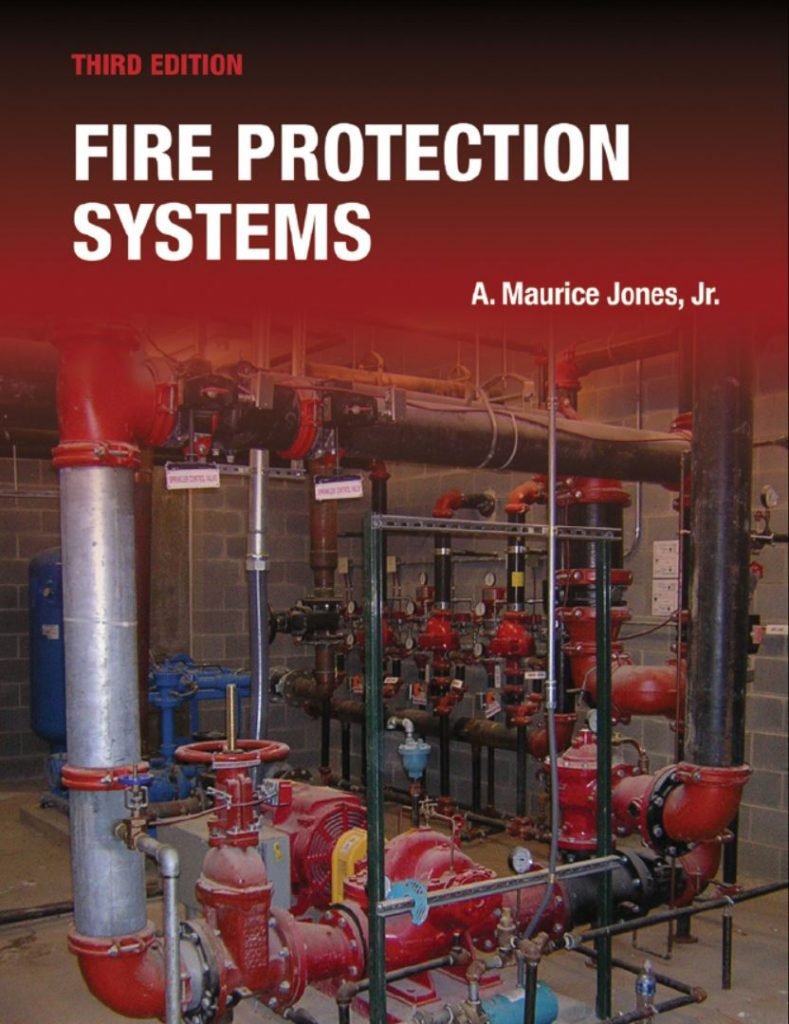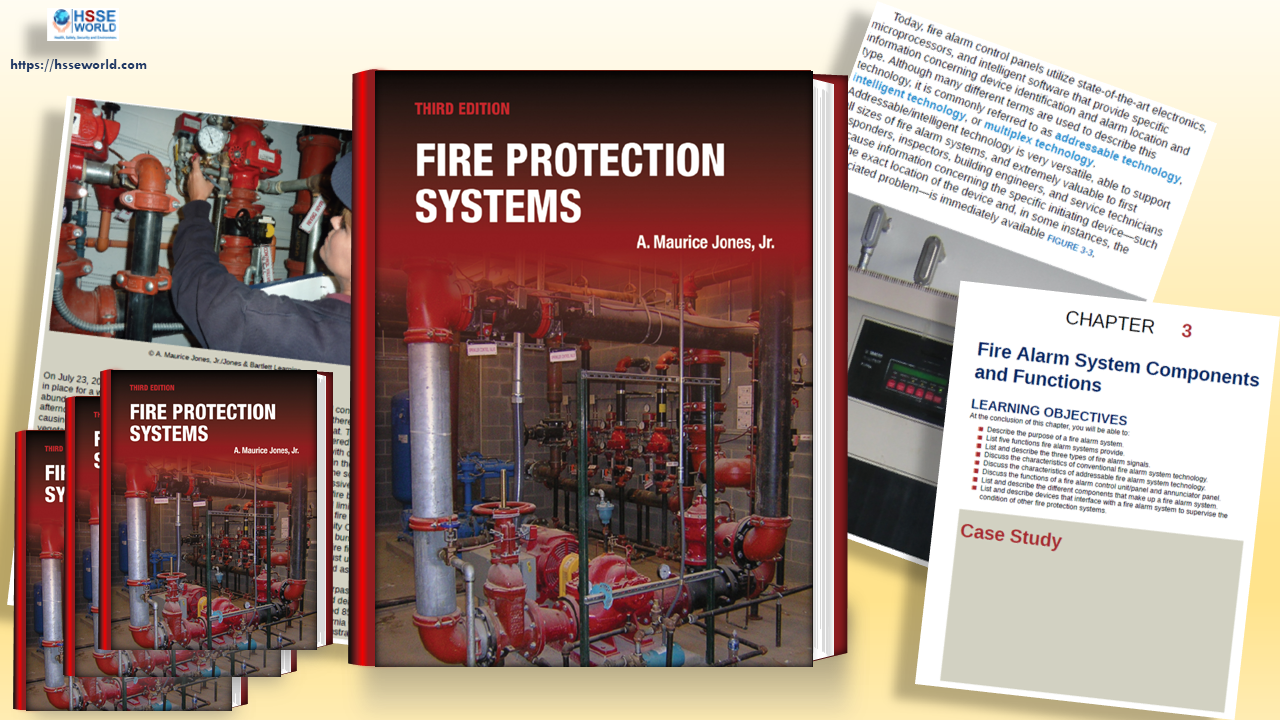Fire protection systems third editions by A.Maurice Jones, jr.
A. Maurice Jones, Jr. is the Supervisor, Fire Protection Systems in the Operations
Division, Community Risk Reduction Section of the Alexandria (Virginia) Fire Department.
Over his 20-year career, he has been responsible for all fire protection system-related
issues throughout the city including fire protection systems plan review, installation, inspection, testing, and maintenance of new and existing fire protection systems including hydrants and water supply; site plan review; and maintaining and updating the city fire prevention code, and is the fire department liaison between other city and external agencies related to building construction, water supply, and site access. Also, he supervised all building and trade plans examiners and was the department’s fire protection engineer. He is an adjunct instructor for the Virginia Department of Fire Programs in the NFPA 1031 Fire Inspector program, Department of Housing and Community Development?s Fire Protection Systems training program, and periodically teaches classes for the International Code
Council. In addition, he is a guest instructor at the Alexandria (Virginia) Fire Departments Fire Professional Development Center, the Arlington County (Virginia) Fire Department’s
Fire Training Facility, and the Fairfax County Fire Department’s Fire Alarm and Sprinkler System Training Facility. He is a former adjunct instructor and Fire Science Curriculum Advisory Committee member at Northern Virginia Community College (NVCC), Annandale, Virginia.

Engineering and designing any fire protection system requires an understanding of fire behavior as it relates to the type and size of the fire hazard the system will protect. Most properties and structures have some level of associated fire hazard that could be negligible, moderate, or significant. When evaluating a fire hazard, several factors come into play, including occupancy and use conditions; the materials, products, and finishes involved in constructing a building; the quantity, arrangement, and type of items within the building; and the method of handling or storing the items that are present. Consideration of all these factors is critical in the hazard evaluation and design process when deciding on the type of fire protection system that will best protect the structure or hazard.

From the moment a building is built and occupied, but especially when buildings change owners or tenants, it is important to ensure that all fire protection systems in the building are adequate for the conditions of occupancy and use. Firefighters performing familiarization drills in buildings must remain cognizant of the occupancy conditions, the types of hazards, the types of processes, and the quantities and types of materials in a property. If any of these conditions change, not only will the building’s preplan and response protocol needs updating, but the adequacy of the fire protection systems will need to be reevaluated. Warehouses are a good example to illustrate this point because it is not unusual for the contents and the storage method to change over time. When the contents and method of storing are changed, the fire hazard could greatly increase owing to a change in the fuel load that could render the fire protection system inadequate.
Contents
The Contents of the Fire Protection Systems
- SECTION 1
- Establishing the Relationship Between Fire Behavior, the Model Codes, and Fire Protection Systems
- CHAPTER 1 Basics of Fire Behavior
- CHAPTER 2 Fire Protection Systems and the Model Code Process
- SECTION 2
- Fire Alarm and Detection Systems
- CHAPTER 3 Fire Alarm System Components and Functions
- CHAPTER 4 Types of Fire Alarm and Detection Systems
- SECTION 3
- Water-Based Fire Suppression Systems
- CHAPTER 5 Water Supplies for Fire Protection Systems
- CHAPTER 6 Standpipe and Hose Systems
- CHAPTER 7 Automatic Fire Sprinkler Systems
- CHAPTER 8 Specialized Water-Based Fire Protection Systems
- SECTION 4
- Special Hazard Fire Suppression Systems
- CHAPTER 9 Fixed Wet and Dry Chemical Extinguishing Systems
- CHAPTER 10 Gaseous Agent Extinguishing Systems
- CHAPTER 11 Portable Fire Extinguishers
- SECTION 5
- Control and Management Systems, Property Security,
- and Fire Protection Systems
- CHAPTER 12 Smoke Control and Management Systems
- CHAPTER 13 Property Security, Emergency Response, and Fire
- Protection Systems
- APPENDIX A: FESHE Correlation Guide
- APPENDIX B: Imperial and Metric Conversions
- GLOSSARY
- INDEX
Download the book
Fire Protection systems -Third edition 2021
More Downloads
- E-Books: Healthcare Hazard Control & Safety Management
- E-Books: Safety, Health and Working Conditions Training Manual
- E-Books: Energy Efficiency in Water and Wastewater Facilities
- E-Books: Fire Service Features of Buildings and Fire Protection Systems
- E-Books: Evaluation of Fire Safety free download
- E-Books: PPE for Chemical, Biological, and Radiological Hazards free
- E-Books: Changing the Workplace Safety Culture free download
- E-Books: Site Emergency Planning Workbook
- E-Books: Load Restraint Guide
- E-Books: Essential Practices for Creating, Strengthening, and Sustaining Process Safety Culture
- E-Books: System Safety Engineering and Risk Assessment
- E-Books: Permit-Required Confined Spaces
- E-Books: Is it Safe to Enter Confined Space?
- E-Books: 5-Minute Workplace Safety Talks
- E-Books: Safety Culture and High-Risk Environments
- E-Books: Practical Guide to Industrial Safety
- E-Books: Slip, Trip, and Fall Prevention for Healthcare Workers
- E-Books: Health and Safety at Work Key Terms
- E-Books: Fundamentals of Process Safety Engineering
- E-Books: Gas Detection Hand Book
- E-Books: Occupational health and safety management systems ANSI-AIHA-z10-2012
- E-Books: Hot Work on Drums and Tanks
- E-Books: Human Fatigue Risk Management
- E-Books: Guidelines for the provision of facilities and general safety in the construction industry
- E-Books: Handbook of Training in Mine Rescue and Recovery Operations ( 2021)
- E-Books: Code of Practice for the Safe Use of Lifting Equipment – Edition 9 (Nov 2019)
- E-Books: Free Forklift Health and Safety Best Practices Guideline
- E-Books: Handbook of Hazardous Chemical Properties
- E-Books: Human Performance Improvement through Human Error Prevention
- E-Books: Principles Of Fire Risk Assessment In Buildings
- E-Books: Investigation of Occupational Accidents and Diseases
- E-Books: Radiation Protection and Safety in Industrial Radiography
- E-Books: Basic Guide to System Safety, Third Edition
- E-Books: Food Safety Management-A Practical Guide for the Food Industry
- E-Books: Safety identification: Escape and evacuation plan signs- ISO 23601
- E-Books: Safety at Work
- E-Books: The Safety-Critical Systems Handbook 4th edition
- E-Books: Fundamental principles of occupational health and safety
- E-Books: Fire Safety Risk assessment Guide – Sleeping Accommodation
- E-Books: Mental health at work series
- E-Books: Live Fire Training: Principles and Practice
- E-Books: Pre-Startup Safety Review Guide
- E-Books: Fire and Emergency Drill Manual and Building Inspection Guide
- E-Books: Health and Safety: Risk Management 5th edition
- E-Books: Fire Protection systems -Third edition 2021
- E-Books: Fire Safety Logbook templates
- E-Books: From Accidents to Zero
- E-Books: Electric Safety Practice and Standards
- Your steps to chemical safety
- E-Books: Ergonomics and Psychology Developments in Theory and Practice
- E-Books: HAZOPS Should BE fun-The Stream-Based HAZOP
- E-Books: Safety Health and Environmental Auditing
- E-Books: A Quick Guide to Health and Safety
- E-Books: Occupational Ergonomics A Practical Approach
- E-Books: Job Hazard Analysis A Guide for Voluntary Compliance and Beyond
- E-Books: Electrical Safety of Low Voltage Systems




